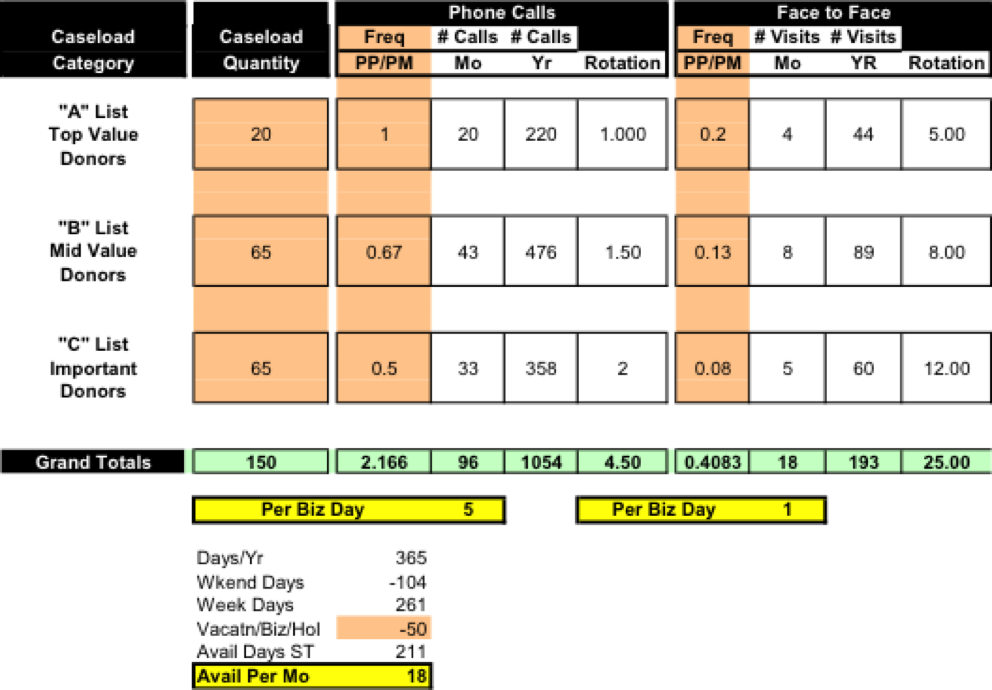
We published this chart several years ago, and it is worth dusting it off and bringing it out again. Here’s why: many MGOs across the country, and MGOs we serve in Canada and Europe, are still treating all donors the same, rather than realizing that there is a hierarchy of value that must be managed.
I think we all know that not all donors are the same – that some have higher capacity and are more engaged than others. We know this stuff. But most every time we go to check how a MGO is managing their caseload, we find that they are using their time with all donors uniformly (a blanket “cookie cutter” approach), or letting personal preference make the decision.
By personal preference I mean: “I just like those people.” Or, “they really need to stay connected to me.” Or, “My boss really feels like I need to stay in touch with them.”
All of these “reasons” have some validity, but they should not drive the choice of which donors a MGO decides to relate to, and how much, on the caseload. This is why we are constantly harping on tiering the donors in some form or another.
We have consistently said that the objective of a MGO and a major gift program is to match the donor’s interests and passions to the needs of society that the organization is meeting. That is what you as a MGO are trying to do. Nothing more. But when it comes to organizing your work you need to take, in our opinion, several factors into consideration:
- First, you have precious little time every month to do your work. It is important to realize this and hold it close to your head and heart so it will guide how you use your time. If you look at the bottom of the chart above you can see that after you deduct weekend days, holidays, vacation, business meetings, etc. etc. from the number of days you have, you only have 18 days a month to get this important work done. Now, of course, you will work on some weekends, I know. But just stay with me on this fact: there is very little time available for you to relate to your caseload donors, so you cannot be out doing anything else but relate to them, no matter what anyone else says.
- Since you have very little time, you must bias your efforts towards donors who can give the most. This is the one area where size of gift IS driving what you do. This orientation is important for two reasons. First, your main duty for the organization is to bring in as much net revenue to fund programs as you possibly can. Secondly, good stewardship demands that you secure the highest return on the cost of your labor. Most MGOs, depending on the size of the organization and where it is located, cost the organization, with all costs in (salary, benefits and operating costs + office etc.) anywhere from $75,000 to $150,000 or more a year. If the MGO does not relate to higher givers and does not secure revenue at an acceptable level, then the return on this cost is very poor – which will then get you into trouble. So this is why you must orient your efforts towards donors who can give the most.
All of these factors explain why tiering donors and paying more attention to some vs. others is so important. Which brings me back to the chart above. There is a lot of technical detail behind this chart, so I will spend little time explaining it. But here are the most important points:
- Your caseload of 150 (or whatever the size) must be tiered A, B, C to show top, mid and lower value donors. The top tier will have the least amount of donors in it. The other two may be the same in size OR the “C” list may have a little more than the “B” list.
- You will need to decide the frequency of phone calls (you could add email touches here) per donor (PP) per month (PM) and the frequency of face to face meetings per donor per month for every tier. Notice that I have placed more emphasis and more frequency on the “A” donors, a little less on the “B” donors and a little less on the “C” donors. These are not sacred numbers. You need to decide what works for you. But the principle you must follow, in our opinion, is that more time needs to be spent with “A” donors with a little less on the “B” donors and a little less on the “C” donors, reflecting your understanding and acceptance of the fact that not all donors are equal in economic value. The rotation column above simply documents that, on the “A” donors, you are contacting them by phone one time every month, and meeting with each “A” donor, on average, every 5th month while you will, on average talk to each “C” donor on the phone every other month and meet with each one once a year. You could bypass the complexity of our approach and just be purposeful to generally bias all activity with your donors with this tiered approach. That is what I am recommending.
In everything you do in your major gift job remember that you are a steward of your time, and it must be used to relate to the donors on your caseload in a manner that reflects your understanding and acceptance that not all donors have the same ability to give to your good cause.
Richard




0 Comments